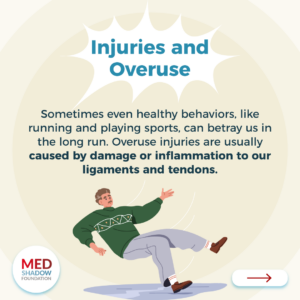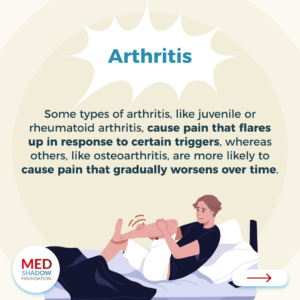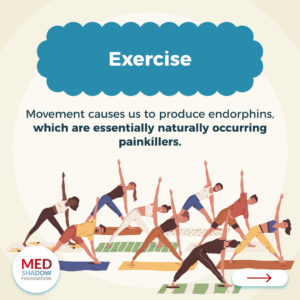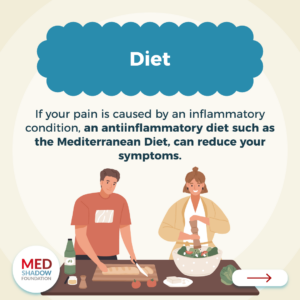“When your whole body is a giant toothache, nothing fixes it,” observes Charley Pavlosky, 65, recalling the systemic pain that plagued him 14 years ago. A lifelong athlete, he was familiar with the aches and pains of being active – he’d even had surgery to repair a disc – but this was new to him.
His chronic pain was so severe that he was only getting two hours of sleep a night, and during the day he experienced anxiety and panic attacks, he told MedShadow.
Those suffering from chronic pain know the reality and seriousness of this condition. It can be anything from an infrequent annoyance, to a life-altering impact. Much like your mental health, chronic pain is often something others cannot see, and therefore don’t always understand.
What is Chronic Pain?
From a technical standpoint, “chronic pain” is pain that lasts three months or more. Sometimes the pain is constant, but in other cases, it may come and go in flares. More than 20% of adults in the US (around 51 million people) report experiencing chronic pain.
What Causes Chronic Pain?
Understanding the underlying cause of your pain is important. Is it due to an autoimmune disease such as lupus, which can be managed with certain types of medications such as BLyS-Specific Inhibitors or corticosteroids? Or is it because of a past incident, like a car accident or old sports injury? Or do you sit in a hunched daily posture that might be better treated with physical therapy? Many types of pain can be treated with medications in the short-term, but if you don’t address the underlying cause, the pain will keep returning. There are many causes of chronic pain. A few examples are included below.
Injuries and Overuse

Often, when you get injured from a fall or a fender bender, you develop some bruises. You might pull a muscle, but over the next few weeks, your body works its magic and remarkably heals itself. Unfortunately, in some cases, your body never quite gets back to its pre-injury function.
That was the case for a 33-year-old man who, after two car accidents, ended up on 14 different prescriptions for his pain. (Read the story of how he eventually managed to cut that number in half, here.)
Sometimes even healthy behaviors, like running and playing sports can betray us in the long run. We can develop overuse injuries, usually caused by damage or inflammation to our ligaments and tendons. Some of the most common areas that athletes or people whose jobs require repetitive movements (like reaching your hand over your head to paint, for example) tend to injure are the feet, knees, hips, shoulders, and elbows.
Poor Posture
Like an overuse injury, sitting in the same position or having poor posture can also lead to chronic pain by weakening important muscles, reducing circulation, or straining joints. Low back pain, which can come from spending too much time sitting with poor posture, is one of the most common types of pain adults experience. Many of us stare at a computer screen much of our workday. Depending on that screen’s position and angle, the tilt of your head can put major strain on your neck and shoulders.
If you’re interested in improving your posture while you sit during the day, read MedShadow’s 8 Hacks to Improve Your Posture.
Arthritis

Arthritis is a group of diseases that cause pain in the joints that can make it hard to move throughout the day. Depending on the type of arthritis, that pain and joint damage can be caused by inflammation or friction.
Some types of arthritis, like juvenile or rheumatoid arthritis, have symptoms that flare up in response to certain triggers, whereas others, like osteoarthritis, are more likely to gradually worsen over time. In addition to diet and exercise, your healthcare provider may prescribe non-steroidal antiinflammatory drugs (NSAIDs), corticosteroids, or disease-modifying drugs (DMARDs) to help these aches and pains. Learn more about treating pain associated with arthritis here.
Read MedShadow’s Foods to Ease Arthritis. If you find that your pain is a trigger-based, flare-up type, it is ideal to track your behaviors with a symptoms tracker to better understand the causes. It also makes for a great tool to bring along with you at your doctor’s appointment.
Endometriosis
Endometriosis is a condition in which tissue similar to endometrial tissue, the tissue that normally lines the uterus, ends up coating other organs. Throughout your cycle, the endometrial tissue thickens in your uterus, and if you don’t become pregnant, it sheds during menstruation.
When similar tissue migrates outside of your uterus, it still responds to the hormonal cues that guide this cycle, causing thickening tissue and bleeding outside the organs, along with scarring, cysts, inflammation, and pain.
Along with diet and exercise, doctors may prescribe NSAIDs, hormonal treatments, or even surgery to treat endometriosis pain. Read more here.
Fibromyalgia
Fibromyalgia is a poorly understood chronic condition characterized by widespread pain that lasts three months or more. Many patients also experience fatigue and mood changes. Because there’s still a lot to learn about the condition, healthcare providers may recommend a variety of treatments from NSAIDs or antidepressants, to cognitive behavioral therapy.
Read Sabrina Miller’s experience with understanding and managing her fibromyalgia here.
Lupus
Lupus is an autoimmune disease, which means your body’s immune system malfunctions and attacks its own tissue. It does this by manufacturing too many B cells, a type of immune cell, which go on to attack your healthy tissue. It can attack joints, skin, and more. The most common type is systemic lupus erythematosus (SLE), which can affect many parts of the body and cause myriad symptoms that include arthritis-like joint pain.
Recovering from Surgery
While surgery may be necessary, it causes a lot of damage to your body, at least temporarily. In order to heal, your body has to first produce a large amount of inflammation. This inflammation often causes you pain. That’s why many surgeons prescribe powerful painkillers for at least a few days after you have surgery.
Read MedShadow’s How to Cut Down on Drugs During and After Endometriosis Surgery for tips on how to plan for your recovery after many types of surgery.
Migraines
While we often think of migraines as headaches, they come with a variety of other symptoms like nausea, constipation, and sensitivity to light, and they can be caused by many different triggers or pain pathways. Jill Dehlin, RN, a migraine patient says she’s tried over 60 different treatments for her migraines.
To learn more about migraines and treatment options, read MedShadow’s The Many Ways to Manage Migraine Treatment.
Chronic Pelvic Pain Syndrome
Pelvic pain occurs between your belly button and your genitals. It can be caused by several different conditions. One of the most common is endometriosis. It can also be caused by fibroids, irritable bowel syndrome, infections and more. Treatments may include pain relievers, antibiotics, antidepressants, hormones, and physical therapy.
Long COVID

Some people who develop symptoms of COVID lasting more than three months report chronic joint and muscle pain. Researchers are still working to unravel how the virus or our immune system’s response to it might lead to symptoms like this, but you can read more about what they know thus far, and how patients are handling it here. It’s important to note that many patients with Long COVID report improvements after about a year.
What is Chronic Pain Syndrome?
Chronic pain syndrome is chronic pain that exists alongside other long-term symptoms like depression, anxiety, and fatigue. It requires a well-rounded treatment approach.
Do Opioids Work for Chronic Pain?
Opioids are powerful drugs, and we know they are some of the most effective treatments we have for pain—at least in certain circumstances. Not all pain is the same, and researchers have started to find that for some types of pain, opioids are no better than over-the-counter (OTC) drugs like Tylenol (acetaminophen) and ibuprofen (Advil).
According to the Centers for Disease Control (CDC), there’s little evidence that opioids are effective at treating pain associated with osteoarthritis, low back pain, headache, and/or fibromyalgia. OTC drugs, antidepressants, lidocaine patches, or anticonvulsants may work better depending on your condition.
Opioids also come with well-known side effects such as the risk for addiction, dependence, and even overdose. You may experience severe withdrawal symptoms when you try to stop taking them. Thus, if other options, such as Tylenol have the potential to limit your pain, they may be safer choices.
Tracking Pain Flares
Researchers still have a lot to learn about pain. The triggers of pain associated with certain conditions like injuries or endometriosis may be clear, even if they’re not easy to modify. However, for some conditions like migraines, lupus or rheumatoid arthritis, the pain can strike seemingly at random. If that’s the case for you, consider using a symptom tracker for a few months to see if certain foods, movements, or other habits regularly precede your pain. If so, you may be able to lessen your symptoms, and even reduce your use of pain medication, by avoiding those triggers!
How Can I Lose Weight with Chronic Pain?
Depending on your condition, losing weight may reduce your pain. For example, if you have osteoarthritis and you carry extra weight, that weight may be putting additional pressure on your joints. Of course, if you feel pain when you exercise or fatigue when trying to plan healthy meals, losing weight may be easier said than done. If you have flares, tracking your triggers may help you have more days when you feel up to getting active.
Studies show that “for every pound increase in body weight there is a four-fold increase in knee joint compressive forces.” With every step you take, your knee is feeling that single pound of weight at a rate four times the amount of force.
An anti-inflammatory diet may reduce pain caused by inflammation and also help you lose weight. Try getting started with MedShadow’s Anti-inflammatory Diet Guide.
MedShadow reader, Madeline Shonka, says that one of the most important strategies she uses for managing her lupus is getting some form of physical activity daily.
“I am staying physically active on purpose. It doesn’t necessarily need to be working out, just moving your body in some way,” she said. On the day she spoke to MedShadow, she said she was in the midst of a flare-up. While she often prefers a more intense workout, when she’s in pain, even just a brief walk can help.
“That’s what I’m able to do,” she adds, “and it gets me outside. It’s something to clear my head and distract me.” On days she feels stronger, she might try a more strenuous exercise routine.
You can search My Active Ingredient to find exercise tips and videos specific to your condition and needs.
Treating Children’s Pain
When your child is in pain, you’re probably willing to do just about anything to make it stop, but some pain medicines, like opioids, raise your child’s risk of developing a substance-use disorder even if he or she only takes them for five days.
If your healthcare provider does recommend pain medications for your child, ask these five questions before you fill that prescription.
Depending on the cause of your child’s pain, lifestyle changes that work for adults such as increasing light exercise for juvenile arthritis or limiting screen time for migraines may help children, as well.
Organizations such as Creative Health for Youth In Pain may be able to offer additional alternatives to strong medications that will help reduce your child’s condition.
Can Chronic Pain Cause High Blood Pressure?
If pain prevents you from being as active as you’d like to be, it can raise your risk of a variety of other chronic conditions, including hypertension. Nearly a quarter of patients receiving treatment at pain clinics in Australia also had hypertension. In one U.S. study, adults over the age of 65 who had hypertension were also more likely to report experiencing chronic pain.
In addition to a variety of medications available to manage high blood pressure, there are many lifestyle changes shown to help. Maintaining a Mediterranean diet and exercising when your symptoms allow are highly effective strategies. Spending time in nature and practicing mindfulness, as well as stress reduction can lower your blood pressure too, even on days when you don’t feel up for a strenuous workout.
Drug-Free Treatments for Chronic Pain
Meditation and Cognitive Behavioral Therapy
It’s important to take a mind-body approach to managing pain. Understandably, chronic pain can lower your mood, but your mood can also impact your pain. In a review of 21 studies on individuals with chronic pain due to varied causes, both cognitive behavioral therapy and mindfulness-based stress-reduction strategies reduced pain and depression.
Physical Therapy
Since many types of chronic pain are caused by sports injuries or from working sedentary jobs, physical therapy can be an effective way to target muscle imbalances and reduce your pain. Getting physical therapy shortly after starting to experience lower back pain reduced pain six months later, among patients with sciatica, according to a 2021 study.

Exercise
Exercise is one of the most important aspects of Madeline Shonka’s routine to manage her lupus pain. Yoga, tai chi, Pilates, and water aerobics are popular low-impact options.
“Movement causes us to produce endorphins, which are naturally occurring opioids,” says integrative medicine pain specialist Heather Tick, MD, associate professor of anesthesiology and pain management at the University of Washington in Seattle.
Search My Active Ingredient to find exercise tips and videos specific to your condition and needs.
Massage
A 2011 study published in Annals of Internal Medicine showed that participants in massage groups reported greater average improvements in pain and functioning compared to those in the usual care group that included a range of treatment options, such as taking pain medications or muscle relaxants, seeing doctors or chiropractors, physical therapy, or simply not doing anything at all. In the study, both types of massages—a common relaxation massage and a more specialized structural massage—improved pain, but before you start, make sure you check your massage therapist’s credentials.
Acupuncture
Reader Jillian Amodio, who has endometriosis, says acupuncture is a very important part of her routine to manage her pain. There is growing evidence that acupuncture can help manage symptoms like chronic pain in some patients. A review of 35 trials found that, for chronic low back pain, acupuncture provided a small amount of pain relief. It can be used alongside other treatment strategies such as exercise.
Acupressure, which is similar to acupuncture but doesn’t include needles (instead a practitioner uses his or her fingers or other tools to put pressure on certain points of your body) can help with knee pain caused by osteoarthritis, according to a 2024 study in JAMA. Better yet, the participants were able to give the treatment to themselves after being trained on the technique.

Diet
Diet can be a powerful tool for lessening certain types of pain. For example, if you track your symptoms you may find that you get migraines after eating particular foods. If you have muscle pain, increasing magnesium intake may help. If your pain is caused by an inflammatory condition, an antiinflammatory diet such as the Mediterranean Diet, can reduce your symptoms. Start by downloading MedShadow’s Whole 30 Diet Guide. The diet helps you eliminate potential triggers then reintroduce them into your diet to help you identify foods that might be triggering your pain.
Biofeedback
Biofeedback is a treatment in which sensors allow you to visualize and learn to control activity in your brain and muscles on a computer screen. It’s sometimes used to help prevent migraines and seizures. A combination of cognitive behavioral therapy and biofeedback was shown to help people manage chronic pain in a 2023 study.
Over-The-Counter Drugs for Chronic Pain
Over-the-counter (OTC) drugs like Tylenol (acetaminophen) and ibuprofen can be powerful tools in managing occasional pain. In fact, in some circumstances they may be as effective as opioids.
However, these medications do still come with risks, especially if you use more than the recommended amount (which around 4-11% of people do). If you have chronic pain, you may take them for a longer period of time so it’s extra important not to take more than the recommended dose, and to check in with your primary care provider regularly.
Side Effects of Tylenol
The main risk of taking Tylenol for aches and pains is liver damage, especially if you drink alcohol while taking it. While it isn’t common, one study in JAMA found that taking acetaminophen at the recommended dose for four days in a row could elevate your risk of liver damage.
Signs of liver damage include:
- Nausea, vomiting, or loss of appetite
- Fatigue or weakness
- Jaundice (yellowing of the skin or eyes)
- Pain in the upper right part of the abdomen
Read more about the risks and benefits of Tylenol in MedShadow’s Need to Know: Acetaminophen.
Side Effects of Aspirin, Advil (ibuprofen), or Aleve (naproxen)
All NSAIDs can cause serious side effects, including stomach ulcers, gastrointestinal (GI) bleeding, kidney failure, heart attacks, and strokes. Aspirin is the exception. It can cause GI bleeding and stomach ulcers, but not heart attacks and strokes. The risk of these side effects of NSAIDs increases if you take higher doses and/or if you take the drug for longer periods of time.
That means if your pain is chronic and lasts for a long time, even more than two or three days, you might consider contacting your healthcare provider rather than continuing to take an NSAID at home.
More common side effects of taking NSAIDs are stomach issues like irritation, pain, heartburn, gas, bloating, constipation, and diarrhea. Taking your NSAIDs with food or milk can help to reduce this effect. Dizziness, mild headaches, problems concentrating, balance issues, and lightheadedness are also common.
Read more about the side effects of NSAIDs in MedShadow’s The Lowdown on NSAIDs for Pain and Need to Know: NSAIDs.
Medical Marijuana for Chronic Pain
There are several categories of marijauna-derived supplements and treatments. Typically, marijuana contains two types of chemicals that are thought to be responsible for most of its effects: cannabidiol (CBD) and tetrahydrocannabinol (THC). Some products contain just one of these ingredients, while others contain a combination of both. On its own, CBD will not get you high, but products that contain THC sometimes can. Your access to these treatments varies based on the laws where you live, as each state sets its own regulations regarding marijuana
There is some evidence that CBD on its own and in combination with THC can help alleviate certain types of pain. Small studies have shown positive results for people with neuropathic pain, associated with conditions such as multiple sclerosis and fibromyalgia.
It’s important to be cautious when purchasing medical marijuana, as every plant and product may be different. Be sure to check the label to see how much of each ingredient is present in the formulation you’re planning to use, and don’t drive or participate in activities that require focused attention until you know how the dose affects you.
It’s important to note that medical marijuana can interfere with other medications, such as blood thinners. See MedShadow’s How CBD Treats Chronic Pain While Yielding Fewer Side Effects for more information about the risks and how to get started safely.
Prescription Pain Medicines
Botox
Botox may be known for its cosmetic use, smoothing wrinkles, because it is a toxin that forces your muscles to relax for a few months at a time. For this same reason, some people find that injections in certain areas, such as the area where the back of your head meets your neck, can prevent migraines.
It’s important to note, however, that since botox wears off, you’ll need these injections regularly, and they can come with side effects such as swelling and bruising. Some patients on AskAPatient.com say they experienced muscle weakness following the injections. In rare cases, botox can spread and cause very dangerous side effects such as difficulty breathing.
Types of Opioids
There are several different formulations and brands of opioids. They include:
- Morphine
- Codeine
- Oxycodone
- Hydrocodone
- Fentanyl
- Methadone
They all impact the same part of your brain to block pain, but they may do so differently. For example, fentanyl is a very potent opioid (50-100 times more potent than morphine) that floods your brain with opioids rapidly, and wears off rapidly, as well. This makes it highly effective for a brief moment, for example for the first hour or so when you come out of surgery.
However, it also makes it much more dangerous if used inappropriately. This potency makes it easy to overdose. It’s sometimes administered in the hospital before, during or immediately after surgery, but while you’re recovering in the hospital, the healthcare providers may transition you to another painkiller such as vicodin (hydrocodone/acetaminophen) or even tylenol.
Still, drugs like vicodin also come with side effects. More than 500 patients have shared their experiences with Vicodin on AskAPatient.com. Some say the drug worked well for their chronic pain. Others describe experiencing severe gastrointestinal upset, an increase in tolerance (requiring higher and higher doses to get the same effect), and panic attacks.
Opioids Interact with Benzodiazepines
Because pain often goes hand-in-hand with mental health conditions like anxiety, about 10% of people prescribed opioids are also prescribed benzodiazepines, a type of antianxiety drug. The two types of drugs enhance each other’s’ effects, meaning that combining the two dramatically raises your risk for overdose.
Do Opioids Affect Older Adults Differently?
As we age, our bodies change. Many senior citizens metabolize opioids (and other drugs) more slowly than they did when they were younger. Individuals in this age group who are prescribed opioids are far more likely to experience dangerous falls than their counterparts who use OTC pain killers.
Can I Drink While Taking Opioids?
It’s best not to drink while taking opioids. The two drugs, alcohol and opioids, both slow your respiratory system. Combining them raises your risk for overdose.
How to Reverse an Overdose
If you are prescribed opioids, your provider should also prescribe naloxone, a drug that comes as a nasal spray or injection that can reverse an overdose almost immediately. If the provider doesn’t prescribe it, you can ask for a prescription. If you forget, many pharmacies now allow you to buy it without a prescription.
Members of your household should know how to use it in the event that you, or any one else, ends up consuming too high of a dose. Administering naloxone is unlikely to cause any dangerous side effects and should be done as quickly as possible if you’re exhibiting signs of an overdose. (In other words, if you suspect overdose, it is safe to administer naloxone. It is far better to provide naloxone if you’re unsure than to not.) First give the person who may be overdosing the dose of naloxone, then immediately call 9-1-1.
Signs of an opioid overdose include:
- Tiny pupils
- Short, shallow breaths
- Sleepiness or loss of consciousness
- Limp body
- Pale, blue or cold skin
- Choking or gurgling sounds.
Is Life Worth Living With Chronic Pain?
There’s no getting around it. Chronic pain can be miserable, and many treatments only provide limited relief. Experiencing chronic pain is a risk factor for experiencing suicidal thoughts and behaviors.
If you have chronic pain, trying to treat your pain is not enough. It’s crucial to proactively manage your mental health as well. Check out MedShadow’s Mental Health Matters article for strategies to treat or prevent depression, anxiety, and other mental health conditions.
Additionally, consider joining support groups where you can connect with others experiencing similar conditions. You can find support groups for chronic pain, or specific conditions that cause pain, such as lupus or fibromyalgia.
Lastly, if you’re having thoughts of suicide, you are not alone. Call or text the suicide hotline at 988 for help and support.






